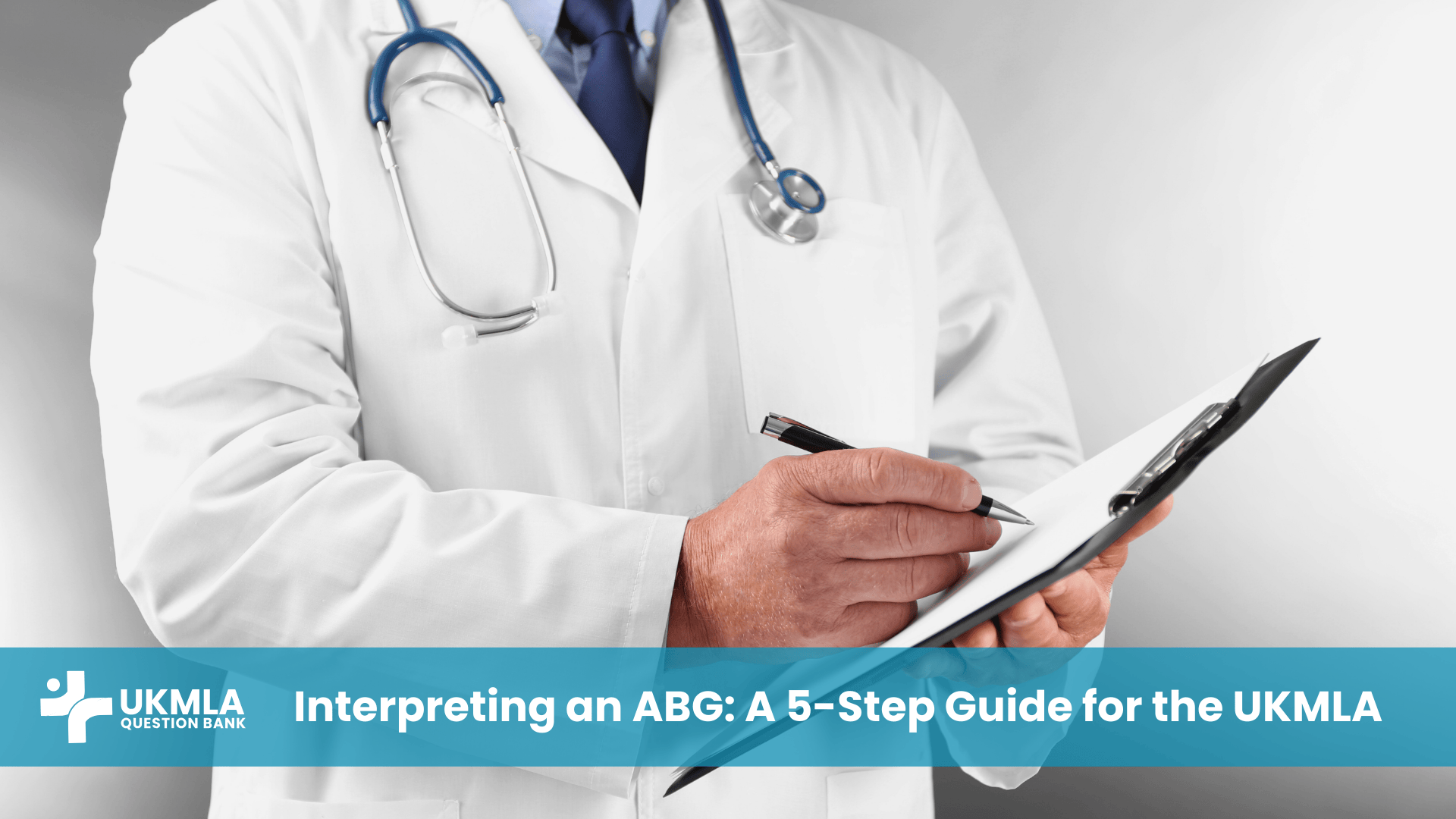Introduction
Mastering abg interpretation ukmla is a fundamental clinical skill and a high-yield topic that frequently appears in the AKT. The ability to look at a set of blood gas results and systematically deconstruct them to reveal a patient’s physiological state is a core competency for any junior doctor. However, faced with a string of numbers and a ticking clock, many candidates can feel overwhelmed and make simple mistakes. The key to success is not just memorizing normal values, but having a reliable, repeatable system to analyze the data. This skill is a core component of interpreting clinical data for the UKMLA AKT.
This guide is designed to provide you with that system. We will walk you through a simple, 5-step method for ABG interpretation that will bring clarity and confidence to your analysis. By mastering this structured approach, you will be able to tackle any ABG question in the UKMLA and, more importantly, apply this crucial skill safely on the wards. This aligns with the principles of maintaining competence as outlined in the GMC’s “Good medical practice”.
Table of Contents
ToggleA 5-Step Guide to ABG Interpretation for the UKMLA
Before you begin, it’s essential to know the normal values. While some exams provide reference ranges, you should have these committed to memory.
Table 1: Normal Arterial Blood Gas (ABG) Values
| Parameter | Normal Range | Represents |
|---|---|---|
| pH | 7.35 – 7.45 | Acidity / Alkalinity |
| PaCO₂ | 4.7 – 6.0 kPa | Partial pressure of Carbon Dioxide (The “Respiratory” acid) |
| PaO₂ | 10 – 13.5 kPa | Partial pressure of Oxygen (Oxygenation) |
| HCO₃⁻ | 22 – 26 mmol/L | Bicarbonate (The “Metabolic” base) |
| Base Excess | -2 to +2 mmol/L | A measure of metabolic disturbance |
(Note: Always refer to your local lab for their specific reference ranges. For a broader overview, see our guide on UK Lab Values for the UKMLA).
Step 1: Check the Patient & the PaO₂ (Is the Patient Safe?)
Before you dive into the complexities of acid-base balance, always look at the patient first. The clinical context provided in the vignette is crucial. Secondly, check the PaO₂. Hypoxia is the most immediate threat to life. A PaO₂ below 8 kPa is considered severe hypoxia and is a medical emergency that requires immediate treatment with oxygen.
Step 2: Check the pH (Acidosis or Alkalosis?)
The pH is the anchor for your acid-base analysis. This single value tells you the overall state of the patient’s blood.
pH < 7.35: The patient has an acidaemia.
pH > 7.45: The patient has an alkalaemia.
pH 7.35 – 7.45: The pH is within the normal range. This could mean there is no disturbance, or it could indicate a fully compensated chronic disorder.
Step 3: Identify the Primary Driver (Respiratory or Metabolic?)
Now you need to figure out what is causing the change in pH. To do this, look at the PaCO₂ (the respiratory component) and the HCO₃⁻ (the metabolic component). A simple and effective mnemonic to use here is ROME: Respiratory Opposite, Metabolic Equal.
The Respiratory Component (PaCO₂)
Think of CO₂ as an acid. When you breathe faster, you blow off CO₂, and your blood becomes more alkaline. When you breathe slower, you retain CO₂, and your blood becomes more acidic. The respiratory system moves in the opposite direction to the pH.
Respiratory Acidosis: pH is low and PaCO₂ is high (opposite directions).
Respiratory Alkalosis: pH is high and PaCO₂ is low (opposite directions).
The Metabolic Component (HCO₃⁻)
Think of HCO₃⁻ as a base. The metabolic system moves in equal (the same) direction as the pH.
Metabolic Acidosis: pH is low and HCO₃⁻ is low (same direction).
Metabolic Alkalosis: pH is high and HCO₃⁻ is high (same direction).
Step 4: Check for Compensation (Is the Body Fighting Back?)
The body strives for balance (homeostasis). If there is a primary acid-base disturbance, the other system will try to compensate to return the pH to normal.
“A systematic approach is non-negotiable in data interpretation. Each step builds upon the last, preventing premature conclusions and ensuring a full, accurate clinical picture is formed.”
If you identify a primary disorder, look at the “other” value to see if it’s trying to compensate:
In a respiratory acidosis (high PaCO₂), the kidneys will try to retain HCO₃⁻ to buffer the acid. You would expect to see a high HCO₃⁻ as compensation.
In a metabolic acidosis (low HCO₃⁻), the lungs will try to blow off CO₂. You would expect to see a low PaCO₂ as compensation.
A key tool for metabolic acidosis is Winter’s formula, which calculates the expected PaCO₂ compensation: Expected PaCO₂ (kPa) = (0.2 x HCO₃⁻) + 1.1 ± 0.3. If the measured PaCO₂ is close to the calculated value, the respiratory compensation is appropriate.
Step 5: Check the “Extras” (Anion Gap and Lactate)
If you have diagnosed a metabolic acidosis, you must take one further step: calculate the anion gap. This helps to narrow down the cause.
Anion Gap Formula: Anion Gap = (Na⁺) – (Cl⁻ + HCO₃⁻)
Normal Anion Gap: A normal anion gap is typically 10-18 mmol/L.
High Anion Gap Metabolic Acidosis (HAGMA): This indicates the presence of an unmeasured acid. Common causes can be remembered by the mnemonic CAT MUDPILES: Cyanide, Alcoholic ketoacidosis, Toluene, Methanol, Uraemia, Diabetic ketoacidosis, Paraldehyde, Iron/Isoniazid, Lactic acidosis, Ethylene glycol, Salicylates. A common cause of HAGMA in hospitalised patients is sepsis.
Putting It All Together: Worked UKMLA-Style Examples
Example 1:
A 68-year-old man with a history of COPD is brought to A&E with increasing shortness of breath and drowsiness. His ABG on room air shows: pH 7.25, PaCO₂ 8.5 kPa, PaO₂ 7.5 kPa, HCO₃⁻ 28 mmol/L.
Patient & PaO₂: The patient is hypoxic (PaO₂ 7.5 kPa). He needs oxygen immediately.
pH: 7.25 is low -> Acidaemia.
Primary Driver: PaCO₂ is high (8.5 kPa). This is opposite to the low pH. The primary disorder is a respiratory acidosis.
Compensation: The HCO₃⁻ is high (28 mmol/L), which is the expected metabolic compensation for a respiratory acidosis.
Extras: Not a primary metabolic acidosis, so anion gap is less relevant.
Interpretation: Hypoxic respiratory acidosis with metabolic compensation, likely a Type 2 Respiratory Failure secondary to a COPD exacerbation.
Example 2:
A 22-year-old female with Type 1 Diabetes is brought in with vomiting and confusion. Her ABG on room air shows: pH 7.15, PaCO₂ 3.0 kPa, PaO₂ 14.0 kPa, HCO₃⁻ 10 mmol/L. Her electrolytes show Na⁺ 135, Cl⁻ 100.
Patient & PaO₂: The patient is not hypoxic.
pH: 7.15 is low -> Acidaemia.
Primary Driver: HCO₃⁻ is low (10 mmol/L). This is in the same direction as the low pH. The primary disorder is a metabolic acidosis.
Compensation: The PaCO₂ is low (3.0 kPa), which is the expected respiratory compensation (hyperventilation, or “Kussmaul breathing”). Winter’s formula: (0.2 x 10) + 1.1 = 3.1 kPa. The patient’s PaCO₂ of 3.0 is appropriate.
Extras: Anion Gap = (135) – (100 + 10) = 25. This is a high anion gap metabolic acidosis (HAGMA).
Interpretation: High anion gap metabolic acidosis with appropriate respiratory compensation. In the context of a Type 1 Diabetic, this is Diabetic Ketoacidosis (DKA) until proven otherwise. This is a situation where you would follow the specific NICE – Diabetic ketoacidosis in adults guideline.
Table 2: Summary of Primary Acid-Base Disorders
| Disorder | pH | PaCO₂ | HCO₃⁻ | Common Causes |
|---|---|---|---|---|
| Respiratory Acidosis | ↓ | ↑ | Normal or ↑ | Opiate overdose, COPD, hypoventilation |
| Respiratory Alkalosis | ↑ | ↓ | Normal or ↓ | Anxiety, PE, hyperventilation |
| Metabolic Acidosis | ↓ | Normal or ↓ | ↓ | DKA, sepsis, renal failure, diarrhoea |
| Metabolic Alkalosis | ↑ | Normal or ↑ | ↑ | Vomiting, diuretic use |
Frequently Asked Questions (FAQ) about ABG Interpretation UKMLA
Acidaemia and alkalaemia refer to the net state of the blood pH (i.e., pH < 7.35 or > 7.45). Acidosis and alkalosis refer to the underlying pathological processes that are causing the pH shift. You can have a mixed disorder with both a respiratory acidosis and a metabolic alkalosis, resulting in a normal pH (no acidaemia).
Base excess is another measure of the metabolic component. A negative base excess (e.g., -5) indicates a metabolic acidosis, while a positive base excess (e.g., +5) indicates a metabolic alkalosis. It is often used in critical care.
A Venous Blood Gas (VBG) is less painful and safer to obtain. It is very reliable for assessing pH and PaCO₂. However, it is not reliable for assessing oxygenation (PaO₂), so an ABG is required if you need to know the patient’s oxygen level.
This is a measure used to assess the severity of Acute Respiratory Distress Syndrome (ARDS). It compares the patient’s oxygen level with the concentration of oxygen they are receiving.
A common mnemonic for NAGMA is HARDUP: Hyperalimentation, Acetazolamide, Renal tubular acidosis, Diarrhoea, Ureteroenteric fistula, Pancreatic fistula.
This is when two or more primary disorders are present at the same time. For example, a patient with COPD (respiratory acidosis) who also has diarrhoea (metabolic acidosis) would have a severe mixed acidosis.
The UK and many other parts of the world use kilopascals (kPa) as the standard unit for partial pressures. In the US, mmHg is used. Be aware of this when reading international resources. To convert kPa to mmHg, multiply by 7.5.
Yes. This represents a fully compensated chronic disorder (e.g., a patient with chronic COPD may have a high PaCO₂ and a high HCO₃⁻, but a pH of 7.36) or a mixed disorder where the effects cancel each other out.
Type 1 Respiratory Failure is defined by hypoxia (low PaO₂) with a normal or low PaCO₂. Type 2 Respiratory Failure is defined by hypoxia (low PaO₂) with hypercapnia (high PaCO₂).
The best way is to use a question bank with numerous clinical vignettes that include ABG results. Work through them systematically using the 5-step method until it becomes second nature.
Conclusion
Confidence in abg interpretation ukmla comes from having a reliable and systematic approach. By consistently applying this 5-step method—checking the patient and oxygen, then pH, then the primary driver, then compensation, and finally the extras—you can deconstruct any ABG result with accuracy and confidence. This transforms a confusing set of numbers into a clear physiological story.
This skill is essential not just for passing the exam, but for safe and effective clinical practice. Practice this method repeatedly with question bank examples until it becomes automatic. A solid grasp of ABG interpretation is a key component of mastering the UKMLA AKT and a hallmark of a competent junior doctor.




